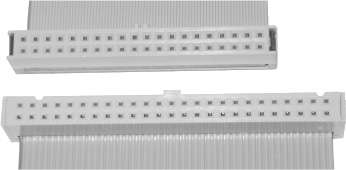Narrow single-ended SCSI cables, connectors, and signals
Narrow (8-bit) SCSI transfer modes use narrow (50-pin) cables. Officially, a narrow cable is called a SCSI A cable, but it may also be called a SCSI-1 cable or a 50-pin SCSI cable. An A cable may use any of several connectors, including standard-density 50-pin internal, high-density 50-pin internal, DD-50 50-pin external, Centronics 50-pin external, and high-density 50-pin external. Narrow SCSI uses 50 signals, each carried on one of the 50 wires in the SCSI A cable, with the 50 wires organized into 25 pairs. For SE SCSI, each pair includes a signal wire and a signal return (ground) wire. Figure 13-5 shows a SCSI A cable with an internal 50-pin connector.

Figure 13-5. SCSI A cable (bottom) with IDE cable shown for comparison
Table 13-10 lists the pinouts for SCSI A cables and connectors. A “#” following a signal name indicates that signal is active-low. In an A cable SCSI bus, (reserved) lines should be left open in SCSI devices, may be grounded at any point, and are grounded in the terminator. All A cables use the same signals on the same conductor in the cable, but the pinouts to the connectors vary by connector type. In the table, “External” refers to a SCSI A cable that uses an external shielded connector. “Internal” refers to an unshielded internal header-pin connector.
Table 13-10. SCSI cable pinouts
|
Connector pin # | ||
|---|---|---|
Get PC Hardware in a Nutshell, 3rd Edition now with the O’Reilly learning platform.
O’Reilly members experience books, live events, courses curated by job role, and more from O’Reilly and nearly 200 top publishers.

